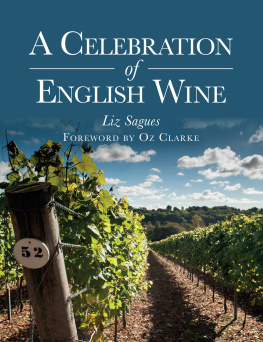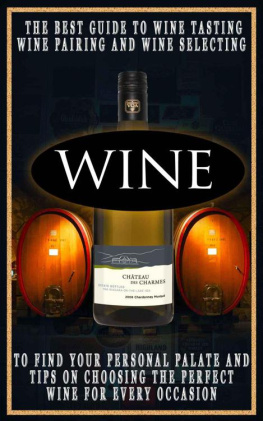A C ELEBRATION
of
E NGLISH W INE

A C ELEBRATION
of
E NGLISH W INE
Liz Sagues
F OREWORD BY O Z C LARKE

ROBERT HALE
First published in 2018 by
Robert Hale, an imprint of
The Crowood Press Ltd
Ramsbury, Marlborough
Wiltshire SN8 2HR
www.crowood.com
This e-book first published in 2018
Liz Sagues 2018
Foreword Oz Clarke 2018
All rights reserved. This e-book is copyright material and must not be copied, reproduced, transferred, distributed, leased, licensed or publicly performed or used in any way except as specifically permitted in writing by the publishers, as allowed under the terms and conditions under which it was purchased or as strictly permitted by applicable copyright law. Any unauthorised distribution or use of thistext may be a direct infringement of the authors and publishers rights, and those responsible may be liable in law accordingly.
British Library Cataloguing-in-Publication Data
A catalogue record for this book is available from the British Library.
ISBN 978 0 71982 615 3
The right of Liz Sagues to be identified as author of this work has been asserted by her in accordance with the Copyright, Designs and Patents Act 1988.
Front cover image: Chris Dixon Photography/Hambledon Vineyard
Back cover images (from left): The Electric Eye Photography/Hattingley Valley,
Hambledon Vineyard, Albourne Estate
Frontispiece: Nutbourne Vineyards
C ONTENTS

F OREWORD
T HE FIRST E NGLISH VINEYARD I VISITED WAS Staple St James, whose wind-swept acres sprawled above Wingham on the Canterbury to Sandwich road. My mum took me there to meet a wonderfully bucolic, rubicund fellow called Bill Ash, who made bone-dry whites whose prickly, hedgerow scents, seasoned by the salty whip of the northerly gales sweeping up from Richborough, I can still taste today. I dont remember the sun shining much at Staple. I dont remember it being warm at all. And Im not sure that the vines are there any more. But I remember proud Bill in his lumberjacks shirt, arms akimbo, gazing out over his struggling vines as the breezes flapped at his ruddy pink cheeks. I hope he knew what important work he was doing. Because his dry huxelrebe had as much a sense of place and person and pride as any wine out of France.
And when I became a wine pro well, I struck lucky again. I clambered and clattered and slithered and stumbled my way down to a hidden eyrie, a tiny golden spot of fairy magic in a fold of the Sussex South Downs. Breaky Bottom. Probably the most beautiful vineyard in Britain. So delicate, so fragile, so precious and held in the loving, caressing bulldog hands of Peter Hall. You learn more about wines, and vineyards, and life yours, his, what life has been, what life could be by an expedition to this tiny paradise than you will from any other vineyard in the land.
And this is the greatest joy of Liz Saguess new book. Whereas I, despite my tremendous enthusiasm for the vineyards that increasingly fan out across our lovely England and Wales, simply havent visited anything like enough, Liz has. And her book shows it. From the very first chapter she isnt merely giving you the dry facts of vineyards, their history and their wine. Every chapter is imbued with a sense of the people, a sense of the places the fields, the rocks, the cliffs and glades; the wispy mist, the sleeting rain, the pale, brave sunshine all of those things that give English wine its unique character. Through her, I can feel the damp and the dry. I can sense the canny, the clever and the callow, and, as I read her words, I can taste the truly original flavours that only our vineyards and our winegrowers can create.
Let me take a couple of sections. The one on grapes. With the current rush to plant the classic champagne varieties, this could be a paean to pinot noir and chardonnay, with the other less fashionable grape varieties trailing muddily behind at a respectful distance. But no. In we dive with two of the most important of Britains grapes bacchus and seyval blanc. Its fascinating to read that Norfolk, of all places, with its cooler summers, but drier, sunnier autumns, may provide the perfect site for bacchus. Its a delight to get caught up in the arguments about seyval blanc, one of Britains most controversial varieties. Owen Elias, for ten years chief winemaker at Chapel Down, the UKs biggest producer, calls seyval hideous, while Peter Hall at Breaky Bottom delights in his seyval as elegant, sweet-natured. And their supporters are fairly evenly divided.
Well, if you want to know more about such people, such grape varieties, and what wines they really produce, at the heart of the book is a memorable run of virtual visits to the vineyards. But Liz isnt just telling you about soil and sunshine, crop levels and canopy management. People make wine, she states bluntly, for better or worse. The final liquid reflects most of all the individual personality of the person who makes it. The fact that Liz starts with Peter Hall at Breaky Bottom, goes on to the Lindo family at Camel Valley in Cornwall, and continues with three fascinatingly different views of the possibilities, the pleasures and the perils of organic grape-growing and winemaking in these isles, shows her as a true enthusiast. But she is also an honest critic and a doughty digger after all the myriad of details, opinions and emotions that churn together at the heart of our English wine revolution.
Oz Clarke

Oz Clarke at the presentation of the inaugural UK Wine Awards in July 2017. He and Susie Barrie (in background) co-chaired the judging panel. TOM GOLD PHOTOGRAPHY/WINEGB
A CKNOWLEDGEMENTS
I M GREATLY INDEBTED TO THE VERY LARGE NUMBER of people who have generously shared information, arranged meetings, guided me through vineyards, answered questions, opened bottles, provided photographs and generally done so much towards the comprehensiveness of this book. If there are errors, they are mine, not theirs. I havent repeated here the names of those people who are quoted or referred to in the pages that follow the words there will, I hope, make clear how much they have contributed. But I want to acknowledge the help of a number whose names do not appear: Jo Alcott, Alison Barclay, Rosamund Barton, Cline Bouteiller, Fiona Campbell, Charlotte Dawber, Olivia Drake, Millie Driver, Steffan Griffiths, Astrid Lewis, Anne Linder, Georgia Mallinson, Steven Morris, Katharine OCallaghan, Sue Olford, Jean Sagues, Jeannette Simpson, Dominic Strange.
A number of illustrations have been sourced through Wikimedia Commons; these are images existing in the public domain or made available under Creative Commons attribution-only licence CC BY 4.0 (http:// creativecommons.org/licenses/by-sa/4.0). Specifically, these are: Chapter 1, Samuel Pepys, John Rose, Castell Coch (by Hchc2009, own work); Chapter 4, phylloxera cartoon, wild grape (Bill Summers @ USDA-NRCS PLANTS Database / USDA SCS. 1991. Southern wetland flora: Field office guide to plant species. South National Technical Center, Fort Worth), vine mildew; and Chapter 5, John Evelyn. The British Library and the Wellcome Library (Wellcome Images) have also been much-appreciated sources of free-of-copyright images.
Next page
















